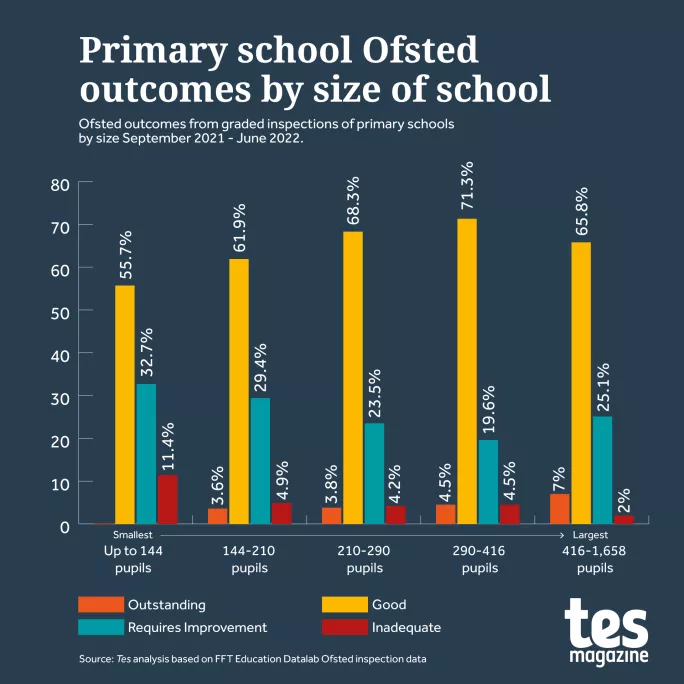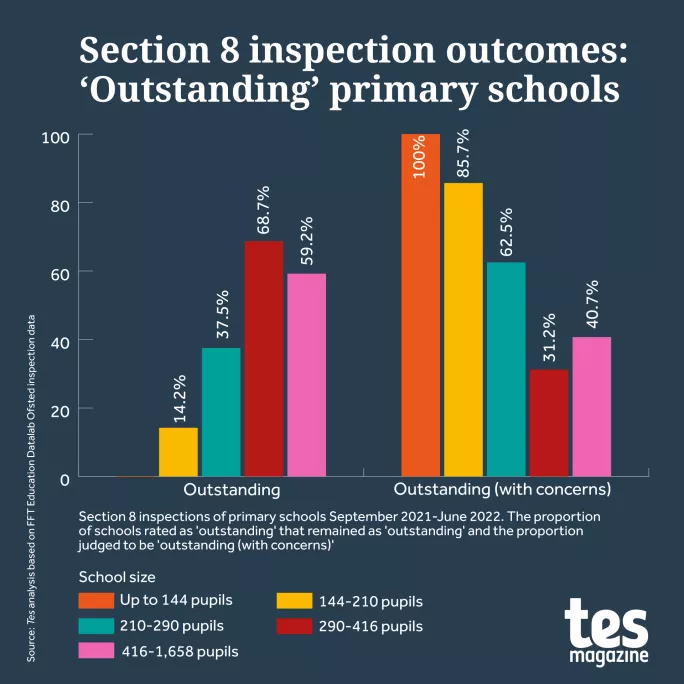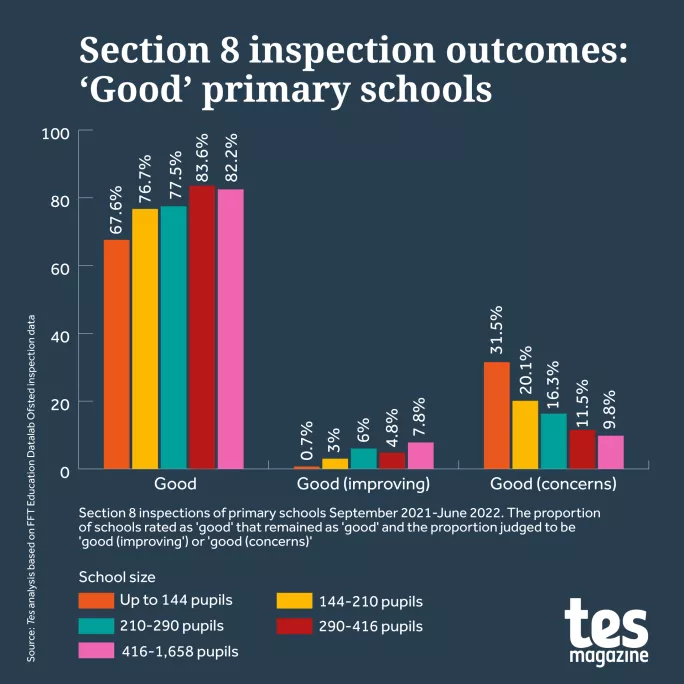Ofsted: Small primaries five times more likely to be ‘inadequate’

England’s smallest primary schools are five times more likely to be rated “inadequate” by Ofsted than the largest ones, according to an analysis of graded inspections.
The findings have fuelled concern that Ofsted’s current inspections framework is more difficult for smaller schools, with leaders calling for more “latitude” in the rating system.
But the inspectorate has said it believes it gives small schools the chance to demonstrate and be recognised for “the innovative ways in which they deliver their curriculum”.
Tes has analysed the outcomes of graded Ofsted inspections at primaries and secondaries over 10 months in 2021-22, which have been broken down by FFT Education Datalab by school size.
The data shows a clear correlation between the size of primary schools and the proportion of schools achieving both top and bottom Ofsted inspection grades.

None of the country’s smallest primary schools - with up to 144 pupils - were rated as “outstanding” in graded inspections by Ofsted during the 10 months from September 2021 to the end of June 2022.
At the other end of the scale, more than one in 10 of the smallest primary schools received an “inadequate” judgement, compared with just 2 per cent of the largest primaries - classed as those with 1,658 pupils or more.
Smaller primary schools have performed less well than larger ones in both full Section 5 graded inspections and in shorter Section 8 inspections.
The findings form part of an investigation into how different types of schools fare in Ofsted inspections.
- Investigation: The ‘big question’ looming over DfE MATs target
- Ofsted: More than two-thirds of ‘requires improvement’ schools avoid new DfE threshold
- Background: What does the future hold for small schools?
Between September 2021 and June 2022, 174 of the smallest primary schools received graded Section 5 inspections - but none were given Ofsted’s top grade.
This compares with 7 per cent of the 199 largest primary schools that received graded inspections during the same period and were judged to be “outstanding”.
Furthermore, the smallest primary schools were less likely to be rated as “good” than larger primaries, and five times more likely to be rated as “inadequate” than the very largest.
The findings have led to concerns about the fairness of the Ofsted framework - with its focus on covering a broad curriculum - for smaller schools.
Neil Short, chair of the National Association of Small Schools, said: “There has been a concern about how small schools can be experts in 11 or 12 subjects when they have three or four teachers.
“I wonder if there is a case to be made for smaller schools to be looked at under a different framework, or for more latitude to be given, because you are not comparing the same thing.”
Mr Short said many small schools face the challenge of teaching across age groups. He said sequencing a curriculum is a very different challenge when “you have all of your key stage 2 pupils in one class”.
Smaller schools have to do more to tailor lessons to individual children, he added.
Smaller schools more likely to be stripped of ‘outstanding’ grade
In the last academic year, Ofsted started routinely inspecting “outstanding”-rated schools, after an exemption that was in place for most of the last decade was lifted.
“Outstanding” schools that have not been inspected since September 2015 now receive a full Section 5 inspection - where a grade is given - while those last inspected after this point get Section 8 inspections, which are shorter and do not result in a grade.
The data, again, shows a correlation between inspection outcome and primary school size.
All 16 of the previously top-rated smallest primaries that underwent a Section 5 visit between September 2021 and June 2022 lost their “outstanding” grade.
In the next biggest group of primaries, 9 per cent retained their “outstanding” grade.
The likelihood of keeping a top grade increases for each of the size groupings, up to 23.8 per cent of the biggest primaries.
Smaller primaries also struggle in shorter inspections
The analysis also looked at unconverted Section 8 inspections of schools previously rated as “good” or “outstanding”.
These shorter inspections do not result in a new rating, but inspectors will say if they have concerns that schools are declining - meaning that they will have a full graded Section 5 inspection on their next visit.
If a “good” school has a shorter Section 8 inspection, but inspectors see improvements underway, the next visit will be a full graded Section 5 inspection with a chance of an “outstanding” rating.
However, in Section 8 inspections of “outstanding” schools, smaller primaries - again - fare less well than larger ones.
The analysis shows that Ofsted had concerns about all 16 of the smallest “outstanding” primary schools that had Section 8 inspections, meaning they will all face a full Section 5 at their next inspection.
Figures from these inspections mostly show that the larger an outstanding-rated primary school is, the less likely Ofsted were to have concerns.

The same pattern of worse outcomes for smaller primary schools compared with larger ones could also be seen in the outcomes of unconverted Section 8 inspections of those rated as “good”.

Is Ofsted’s subject focus more difficult for smaller primary schools?
Aiden Gray, a former Ofsted divisional manager, said he believed that the data shows how the inspectorate’s latest framework had made it more difficult for smaller schools to get top ratings.
Ofsted’s current Education Inspection Framework was launched in September 2019 but the Covid pandemic has meant that 2021-22 is the first full academic year that it has been used in schools.
The framework places an increased emphasis on the school curriculum and on the way subject teaching is planned, sequenced and delivered.
Ofsted assesses curriculum as part of its judgement of the quality of education in schools.
It does this partly through “deep dives” into different subjects to explore the intent, implementation and impact of the curriculum.
There have been concerns that this approach risks looking at primary education through a secondary lens, and is particularly difficult for smaller primary schools, where one member of staff might be the subject lead for several different subjects.
Mr Gray, who now works as a consultant to primaries, said he knew of one small primary school where the headteacher was also the subject lead in three or four different areas.
An Ofsted spokesperson said: ”We understand that small schools face some particular challenges because of their size, however, we always take each school’s circumstances into account on inspection, including the very smallest.
“Under the EIF, we rightly expect all children to have access to a high-quality curriculum. And we believe our inspections give small schools the opportunity to demonstrate, and be recognised for, the innovative ways in which they deliver their curriculum so that their children thrive.”
Were previous frameworks too ‘generous’ to primaries?
Mr Gray also suggested that previous Ofsted frameworks may have focused more on maths and English than the other subjects.
Mr Gray added: “I know that there had previously been a concern within Ofsted in earlier frameworks that smaller schools were being graded more generously.”
However, this was no longer the case, he said, stating: “It is certainly true that the current framework does favour a secondary school approach.
“And it is, obviously, more challenging to be a subject lead across several subjects and also planning a curriculum to be taught across multi-age groups.
“I think the Ofsted outcomes do point to a challenge facing smaller primary schools.”
Mr Gray said that a solution could be to see more small primary schools working together to share subject leaders across more than one school.
‘More suited to secondaries’
James Bowen, director of policy at the NAHT school leaders’ union, said the organisation has had longstanding concerns about how Ofsted’s inspection framework would work with smaller schools before it first launched in September 2019.
Activities like subject “deep dives” were “designed to suit a model of curriculum leadership more relevant to secondary schools than primaries”, he said.
He added: “There is a clear and obvious difference between a secondary school model, where you tend to have entire departments dedicated to individual subjects, and small primary schools, where one teacher may be leading three or four different subjects, and won’t necessarily have the background in those subjects that a secondary subject leader would likely have.”
Ofsted has recently recognised this “to an extent”, and had “made changes to try to ensure that primaries and smaller schools are treated fairly”, he said.
However, he urged the inspectorate “to continue to think carefully about how the framework can be applied proportionately and fairly to all schools”.
How did smaller secondary schools fare?
The inspection data also showed that smaller secondary schools were less likely to achieve an “outstanding” rating than larger schools.
Only two of the smallest 95 secondary schools - with up to 665 pupils - were rated as “outstanding” (just over 2 per cent), compared with 13.1 per cent of the biggest secondary schools, which have at least 1,376 pupils.
However, the correlation between outcomes and size of school was less clear than in Section 5 primary school inspections.
Three-fifths of the smallest secondary schools were judged to be “good”, compared with 50.8 per cent of the largest secondary schools.
The third largest quintile of schools - those with between 906 and 1,112 pupils - had the highest proportion of “good” schools, with 65.1 per cent of schools rated “good”.
You need a Tes subscription to read this article
Subscribe now to read this article and get other subscriber-only content:
- Unlimited access to all Tes magazine content
- Exclusive subscriber-only stories
- Award-winning email newsletters
Already a subscriber? Log in
You need a subscription to read this article
Subscribe now to read this article and get other subscriber-only content, including:
- Unlimited access to all Tes magazine content
- Exclusive subscriber-only stories
- Award-winning email newsletters
topics in this article



